High-accuracy brake fluid tester pen is based on the change of electrical conductivity to measure the change of brake fluid, The water content is 0%‑4% representing no water and the amount of water content in turn, so that car owners can quickly understand whether the water content of the brake fluid is qualified. It is made of ABS material, which is moisture-proof and impact-resistant.
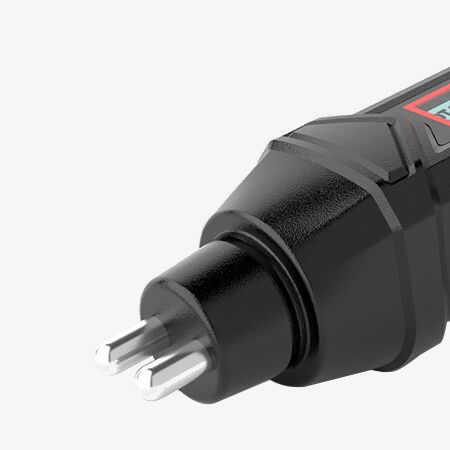
High-Sensitivity Quick-Response Probe Ensures Accurate and Stable Detection
- High-Sensitivity Probe: Equipped with advanced sensors, the probe quickly detects moisture levels in brake fluid, providing fast and reliable results.
- Accurate Measurements: The sensitive probe ensures precise readings even when water content is minimal, reducing false alarms or errors.
Quick Response: SISCO brake moisture tester provides almost instantaneous feedback, allowing multiple vehicles or samples to be tested efficiently. - Durable Construction: The probe is designed to withstand repeated use and exposure to brake fluid without degradation, ensuring long-lasting performance.
- User-Friendly: Easy to operate with a simple dip-and-read method, making it convenient for both professional mechanics and car owners.
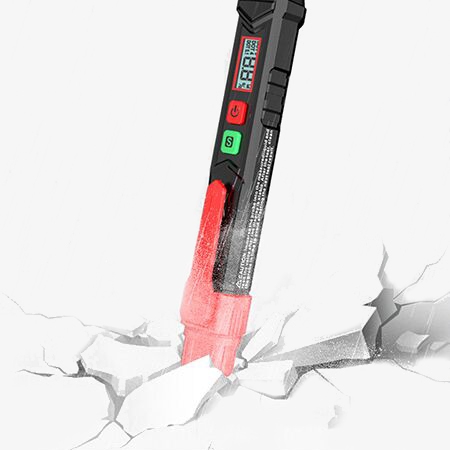
The Brake Fluid Tester Pen is Made of Durable ABS material, Drop-Resistant and Rust-Resistant
- Durable ABS Housing: Made with high-quality ABS plastic, the car brake fluid tester pen is lightweight yet strong, providing excellent resistance to drops and everyday wear.
- Impact-Resistant Design: The sturdy ABS body protects the internal circuitry from accidental falls or workshop impacts, ensuring reliable long-term use.
- Rust-Free Construction: Unlike metal casings, ABS material does not corrode or rust when exposed to brake fluid or humid environments, keeping the tester in good condition.
- Comfortable Grip: ABS plastic also offers a smooth, ergonomic grip, making the tester easy to hold and operate during frequent checks.
Dimension
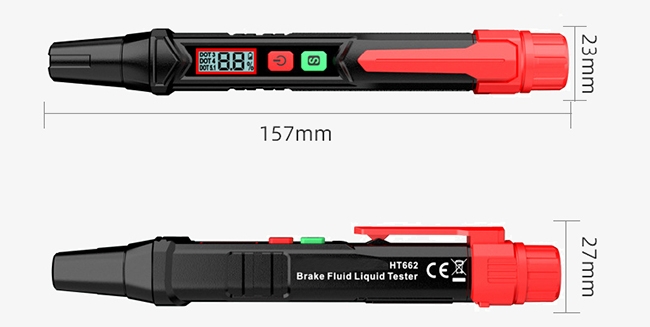
Applications
SISCO brake fluid tester is widely used in automotive workshops, inspection stations, fleet maintenance, and by car owners for routine vehicle care. It quickly detects moisture content or boiling point changes in brake fluid, helping ensure reliable braking performance and compliance with DOT standards (DOT 3, DOT 4, DOT 5.1). This makes it an essential tool for mechanics, inspectors, and drivers to maintain safety and prevent brake failure.
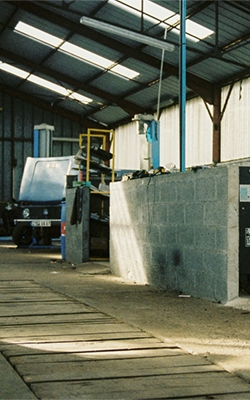
Inspection Stations
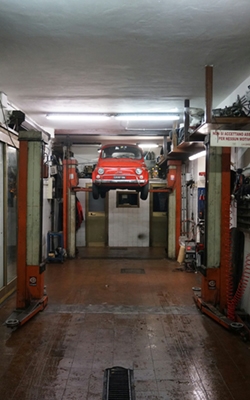
Fleet Maintenance

Automotive Workshops

Routine Vehicle Care
| Model | SISCO-BFT-HT662 |
| Moisture Detection Range | 0%~4% |
| Error | ±0.3% |
| Display | LCD display |
| Alarm Mode | Audio-visual alarm |
| Backlight | Red and green backlight |
| Moisture Indicator | Beep tone changes from slow to fast, backlight changes from green to red, and LCD display value changes from small to large |
| Auto Shutoff | Automatically shuts off after approximately five minutes without any button operation or sensor signal |
| Battery Low Voltage Indicator | √ |
| Power Supply | 2. 1.5V AAA batteries (not included) |
| Ambient Operating Temperature | 0~40°C |
| Dimensions | 157*27*23mm |
| Weight | 50g |
Q1: What is a brake fluid tester?
A1: A brake fluid tester is a tool used to check the condition of brake fluid in a vehicle. It measures factors like water content or boiling point, since moisture in brake fluid lowers its effectiveness and can lead to brake failure. By providing a quick pass/fail or percentage reading, it helps determine whether the brake fluid is safe to use or needs to be replaced.
Q2: What types of brake fluid can a brake fluid tester test?
A2: Most brake fluid testers are designed to test glycol-based fluids, including DOT 3, DOT 4, and DOT 5.1. These are the most common types used in passenger cars and light trucks. They are not suitable for DOT 5 silicone-based brake fluid, which requires different testing methods.
Q3: How does a brake fluid tester work?
A3: A common brake fluid tester works by submerging its electrodes into the brake fluid, then measuring the electrical conductivity of the fluid. Because brake fluid naturally absorbs water over time, this water increases its conductivity. The tester uses a traffic light system of LEDs to indicate the percentage of water content and the overall condition of the fluid, with green meaning no water and red indicating a high level of moisture that requires a brake fluid flush.
Tips: What happens if the tester shows high moisture levels?
If a brake fluid tester indicates high moisture levels, it means the brake fluid has absorbed more water than is safe for proper braking performance. Because brake fluid is hygroscopic, it naturally takes in moisture from the air over time. Once the water content becomes too high, the boiling point of the fluid drops significantly. This can lead to dangerous conditions such as vapor lock, where the fluid forms vapor bubbles under high heat, resulting in a spongy brake pedal or even complete brake failure during emergency stops or downhill driving.
In addition to lowering the boiling point, excess moisture also causes internal corrosion within the brake system. Components such as the master cylinder, brake lines, calipers, and ABS modules can rust or seize, leading to costly repairs and reduced vehicle safety. Moisture-contaminated brake fluid may also compromise the performance of modern electronic braking systems.
Thank you for buying industrial test and measurement equipment on SISCO.com, all products sold by SISCO and the partner cover a 12 months warranty, effective from the date of receiving the products.
What is covered?
SISCO is responsible for providing free spare parts, and free technical support to assist the customer to repair the defective products until the problem is solved.
What is not covered?
- Product purchased from anyone other than a SISCO store or a SISCO authorized reseller.
- Expendable parts.
- Routine cleaning or normal cosmetic and mechanical wear.
- Damage from misuse, abuse or neglect.
- Damage from use of parts other than SISCO approved.
- Damage from use outside the product’s usage or storage parameters.
- Damage from use of parts not sold by SISCO.
- Damage from modification or incorporation into other products.
- Damage from repair or replacement of warranted parts by a service provider other than a SISCO authorized service provider.
- Damage caused by the application environment not meeting the product usage requirements and the failure to perform preventive maintenance.

